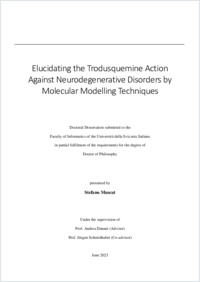Elucidating the trodusquemine action against neurodegenerative disorders by molecular modelling techniques
- Muscat, Stefano
- Danani, Andrea (Degree supervisor)
- Schmidhuber, Juergen (Degree committee member)
- 2023
PhD: Università della Svizzera italiana
Trodusquemine
Aminosterols
Molecular dynamics
Enhanced sampling
Coarse grained
OPES
Molecular modelling
Alzheimer's disease
Computational biophysics
English
The significant increase in life expectancy worldwide has drawn scientific attention to age-related pathologies, such as Alzheimer's disease (AD). The amyloid hypothesis asserts that AD results from abnormal aggregation of specific amyloid proteins, leading to intracellular inclusions or extracellular aggregates in specific brain areas. Trodusquemine, an aminosterol isolated from the dogfish shark Squalus acanthias, has been found to modulate the kinetics of aggregation of the amyloid peptides responsible of AD. However, the mechanism by which aminosterols protect the neuron interacting with the cell membranes and modulate their properties remains unclear. This PhD thesis employs computational molecular modelling to investigate trodusquemine molecular mechanism of action. Molecular dynamics (MD) simulations are used to elucidate trodusquemine interaction with the cell membrane and its self-aggregation mechanism at the molecular level. Utilizing computational methodologies, the present study provides insights into the modulation of the cell membrane physicochemical properties by trodusquemine. Consequently, this modulation confers a reduced vulnerability of the cell membranes to the deleterious effects of misfolded protein aggregates. However, computational limitations often hinder the ability to investigate biomacromolecule conformational properties. The limitation mainly results from biological system’s rough energy landscapes, with many local minima separated by high-energy barriers. Therefore, MD simulations face the challenge of adequately sampling experimentally pertinent timescales ranging from milliseconds to seconds. Presently, classical MD simulations employing atomic resolution are confined to few microseconds. This work benefits from the development of a coarse-grain model to accelerate trodusquemine's dynamics and investigate supramolecular structures. Coarse-grain approach highlights the trodusquemine ability to modulate the coexistence of liquid-gel and liquid-disorder phases, influencing the lipid membrane thermodynamic stability. Furthermore, enhanced sampling techniques and dimensionality reduction methodologies are applied to estimate fundamental thermodynamic properties of aminosterol molecules. The outcomes of this research represent an essential step in designing small molecules capable of protecting neuron cell membranes from the toxicity of amyloid oligomers.
- Collections
- Language
-
- English
- Classification
- Computer science and technology
- License
-
License undefined
- Open access status
- green
- Identifiers
-
- NDP-USI 2023INF011
- URN urn:nbn:ch:rero-006-121409
- ARK ark:/12658/srd1325648
- Persistent URL
- https://n2t.net/ark:/12658/srd1325648
Statistics
Document views: 217
File downloads:
- 2023INF011: 115
